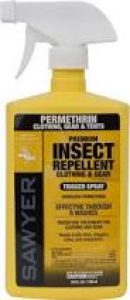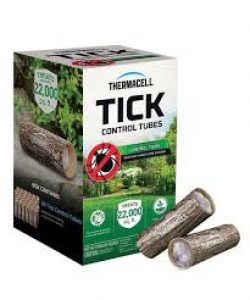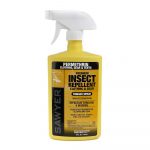People in tick-prone areas often look for any means necessary to keep ticks out of their yard. We know that keeping grass trimmed down to short levels helps, and it is important to keep your main outdoor living areas away from the perimeter of your yard. Any steps you can take to keep ticks away from your family or your pets is effort-well-spent.
One effective technique for those who are willing to invest a little time in preventative tick elimination is to use tick tubes.
Tick tubes are a promising addition to the arsenal of tick-fighting strategies. These devices are biodegradable, and can help control the tick population. They are almost like playing jujutsu against the ticks — using their own techniques and habits against them.
Because deer (or blacklegged) ticks are often present in places where mice tend to be, and like to use mice as a host, it makes sense that treating the mice can help prevent ticks. It might sound a little crazy that you are trying to take care of rodents in your yard, but the idea is attempting to outsmart nature.
Basically, you are using the mice to get rid of the ticks. Brilliant!
A Refresher on How Ticks Live
To understand how tick tubes work, it is useful to recap the life cycle of a tick.
According to the Center for Disease Control, the life cycle of a tick lasts for two years. The adult ticks feed and mate on large animals like deer in the fall and early spring months of the year. After breeding and gorging on blood the female ticks drop off of the host animal and lay their  eggs on the ground. The eggs will hatch in the summer months, and the tick larvae is born.
eggs on the ground. The eggs will hatch in the summer months, and the tick larvae is born.
This is where the mice come in. The tick larvae feed on smaller animals like mice and birds during the summer and the early fall months. Then the larvae are inactive until the spring of the year when they molt and become tick nymphs.
The nymphs continue to feed on small animals, especially rodents like mice and squirrels, and on birds during the late spring months and into the summer. The nymphs molt into adult ticks during the fall, and this completes their two year life cycle when they breed and produce the next generation of tick.
Why are the mice so important? The tick larvae are not actually born with the Lyme disease present in them, they become infected with Lyme disease while feeding on small rodents, especially mice. The bacteria of the Lyme disease stays present on the tick larvae as grows into a nymph and then eventually into adulthood.
The infected tick then bites larger mammals like deer, dogs, or humans, and spreads the Lyme disease up the chain.
Back to the mice, they are everywhere. You might think that you do not have mice or rodents close to your home, but mice are almost always present neaby. According to the EPA (Environmental Protection Agency) mice spread about 35 different diseases to humans through indirect contact such as contact with ticks, fleas, and mites that have used the rodents as a food source, and directly through their droppings, urine, and saliva.
How Tick Tubes Work
Unlike many other types of tick or bug repellent devices, tick tubes are not designed to kill ticks on contact. They are a preventive measure that reduces the population of ticks and thus reduces the risk of your exposure to diseases like Lyme disease. According to the U.S. National Library of Medicine National Institute of Health there is evidence that taking personal protective measures to reduce the human contact with Blacklegged Ticks decreases the occurrences of Lyme disease and creates a safer environment for humans and animals in the area.
population of ticks and thus reduces the risk of your exposure to diseases like Lyme disease. According to the U.S. National Library of Medicine National Institute of Health there is evidence that taking personal protective measures to reduce the human contact with Blacklegged Ticks decreases the occurrences of Lyme disease and creates a safer environment for humans and animals in the area.
Tick tubes have an outer cardboard shell that contains cotton wadding that has been treated with permethrin. The permethrin treated cotton wadding is gathered by mice and rodents and used to line their nests with. This cotton wadding stops ticks and fleas from living on the mice as hosts so the number of ticks present in the area is reduced.
The permethrin in the cotton wadding will rub onto the fur off the mice and bind with the oils in the mice fur and turn the mouse into a walking tick repellant. Ticks will be far less likely to want to crawl all over the permethrin covered mice, and the ones that make it back to the mouse nest will just be exposed to greater amounts of permethrin.
Tick tubes will not leave a pesticide residue on your plants or lawn. They do no known harm to the mice that make nests out of them, and they don’t appear to leach pesticide into the ground if they are rained on. They are emerging as one of the safer methods of reducing ticks in and around your home. They have an added blessing of being able to reduce the number of fleas in your yard.
Tick tubes are seemingly safe to most pets, especially dogs. Some studies show that permethrin might not be good for cats (more on that below) and it should not be placed near any place where aquatic animals may live, but as with anything on this (or other) websites, the science is constantly evolving. On the flip side, your pets should be exposed to fewer ticks and fleas, which is a major positive.
What is Permethrin?

Permethrin is synthetic form of a natural pesticide called pyrethrum. Pyrethrum is extracted from the flower heads of chrysanthemums. permethrin works as a neuro-toxin to ticks.
Permethrin in mild concentrations is also approved by the Food and Drug Administration as an ingredient in lice treatments designed to be used on humans of all ages. In heavier concentrations, it tends to work well on bugs and insects of most types, and has been shown to work quite well on ticks. Mosquito-and-tick repelling clothing is most often treated with permethrin, as the main repelling ingredient.
An important point: Permethrin kills bees. This is why we don’t just spread permethrin around yards, forests, and grasslands. It would be great to not have to worry about ticks, but the cost to the bees would be far too much to even consider. That is why using it in more controlled and confined settings, like a tick tube, is preferred. We don’t use permethrin lightly, but when used in a highly-targeted manner, which a tick tube most definitely does, it can be one of the most effective things against ticks that we know of today.
3 Recommended Tick Tubes
We like tick tubes that are easy-to-use, inexpensive, and biodegradable.
We have looked at many types of tick tubes, and came up with a short list of recommended products. Three tubes on the market today that we are are fans of include:
Thermacell Control Tube

The Thermacell tick tube is one that can easily be found online or in many stores, and it works well. Sold in various quantities, it works well if you can find the right spots to place them — ideally, protected spots that won’t get soaking wet over and over. You typically put them out twice a year. Six of the tubes will cover about 1/4 of an acre, which is the size of the typical suburban yard. If you live in a rural setting with more space and outbuildings, you may want to double or triple that number.
It is probably the tube that we see most often these days. Find it here.
Damminix Tick Tube
Damminix makes a reliable tick tube that is found at several major retailers. Biodegradable and affordable, it comes in packs of 24. The maker says that 24 tubes should give you 1/2 acre of coverage, but field reports suggest that you can get more coverage than that in many situations. They use permethrin as the anti-tick ingredient. You will spend a few bucks on it, but that investment pales in cost when compared to acquiring Lyme disease. To us, this one is the gold standard.
TCS Tick Box
While it is a little harder to find, and not really a “tube”, the TCS Tick Box focuses on the same insecticide technology as tick tubes. Mice go inside the larger box, and as they move around are applied a dose of insecticide that then kills the ticks that are living on them. The TCS tick boxes actually tested as being more effective than tick tubes, but they are not as inexpensive or easy to put all over your yard like tick tubes are.
Make Your Own
Some people make their own tick tubes, and there are many videos on Youtube showing you how. Given the need to make these correctly, though, we suggest going with one of the manufactured products above who has the process built with quality control.  Still, if you want to give it a try, just make sure you are using real permethrin, which you can find here.
Still, if you want to give it a try, just make sure you are using real permethrin, which you can find here.
How to Best Use Tick Tubes in your Yard
The efficient way to use tick tubes in your yard is for you to place the tubes in locations where you see mice and rodent activity. They will find the tubes and instinctively use the cotton wadding inside them as they build nests.
How many tubes do you use? It depends on the size of the area you are trying to control.

If you have about an acre of land you can figure that half of that acre is taken with the house, the cleaned yard, and places where the mice are less likely to be. You want to place the tubes in places where the mice feel comfortable taking the time to go inside the tube and remove the cotton, or in old sheds and structures where you know mice tend to be active. For a piece of property this size you will want to use about 24 of the tick tubes.
Note that when measuring how many tick tubes to use, you take into account the grassy, woodsy, and brushy part of your yard. Don’t calculate the area that is covered by your house, a driveway, sidewalks, water, etc. Some general rules of thumb are:
- 12 tubes for an area of 1/4 acre or less of mouse habitations or environments
- 24 tick tubes will treat between 1/4 acre and ½ acre
- 36 tick tubes will treat ¾ acre
- 48 tick tubes will treat an acre
- 96 tick tubes will treat 2 acres
Large properties can be protected with bulk sizes that are available to professional installers.
The actual number of tick tubes that you will need may be greater depending on your property and the number of mouse attractants you have on that property, as well as if you live in an area particularly prone to deer ticks.
Where do you find the mice? Mice that live outside often make burrows in the ground. This protects them and their young. Mice are generally nocturnal creatures so they can avoid their main predatory enemies like cats, dogs, and chicken hawks. Snakes and owls are also great mouse hunters.
If you have a feed room where you store items like chicken feed, dog feed, or planting seeds, then mice are going to be living within a close proximity to this room. They may even establish a home in the walls of a room like this, or beneath a room like this in a burrow in the ground.
Old sheds are also a place where you will often see mice or mouse nests. Mice like the protection of an old shed, and are often left in peace for months at a time while homeowners deal with the winter months.
Place your tick tubes close to the following locations on your property:
- If you have an area where you have piles of limbs, trash, or discarded items then mice will live close to these areas.
- If you have a storage shed then there is a good chance that a mouse lives in it or very close to it.
- If you have areas of dense shrubbery around your property then there is a good chance that mice live in it or close to it.
- Close to bird feeders where the birds will be dropping seed
- Close to vegetable gardens
- Close to root cellar entrances
- Anywhere there is a lot of leaf matter on the ground
- Compost piles
- Wood piles or piles of discarded branches or brush
- Under flower bushes and decorative bushes
- Near, around, and inside rock landscape features or other rock piles
To learn exactly where to place your tick tubes and the exact number of tick tubes that you will need you should check your tubes every few days to see if the mice and rodents are removing the cotton wadding. This will educate you as to where you should place larger numbers of tubes the next time you put them out, and where the tubes are ineffective.
Do not put the tick tubes in areas that are lit at night because the mouse would prefer to remain in the shadows where it is less likely to be seen by a predator.
How Often do I Refresh Tick Tubes?
You only need to put tick tubes out twice a year. They need to be put out in the spring and then again in the summer.
All of the tubes we recommend above are biodegradable, so you do not need to recollect them when they are spent.
Do Tick Tubes Attract Mice?
You probably already have mice in your yard, you just don’t see them. Mice have a range that entires all of North America and Europe, and for that matter, most of the world. They are nocturnal, so just because you don’t see them running around your yard during the day doesn’t mean you don’t have them.
However, you may want to avoid setting the tick tubes right next to your house, especially if you have an older house that is not sealed the way new houses are. The last thing you want to do is encourage mice to move from the far reaches of your yard to an area within a few inches of your foundation. That is why we suggest setting tick tubes around your yard and any sheds or landscape features, and perhaps not adjacent to your house.
Do Tick Tubes Work?
Yes. While it is always a little difficult to be measuring the absence of something we believe tick tubes work and the science would back us up.
The NIH did a 2-year study on tick tubes, and found that when tick tubes are placed in a wooded yard, between 24% and 48% of the tubes have been used by mice. For the box-style product that uses the same insecticide technology, the usage rate by mice shot up to 61% to 95%. This suggests that these technologies do, in fact, work, but you may want to put many out in your yard, sheds, and outbuildings.
We think it is a pretty easy, passive way to try to address tick issues in your environs, and is definitely worth doing.
Tick Tube / Permethrin Safety
We are still learning about all chemicals, including pesticides. While permethrin appears to be safe in the tick tube setting, we will keep this article updated based on the latest findings.
According to the Environmental Protection Agency permethrin is safe to be used externally. This compound is not absorbed through contact with the skin even if the permethrin is liquid and is spilled onto the skin. Less than 1% of permethrin would be absorbed into the skin if liquid permethrin were poured onto your skin.
According to the University of Rhode Island’s Tick Encounter Resource Center (TERC), someone weighing 140 lbs would likely not experience adverse effects of being exposed to 32mg of permethrin daily.
The National Pesticides Information Center (NPIC) reports that wet permethrin can be extremely toxic to cats and aquatic life, and may be toxic to bees and beneficial insects living in the area.
Finally, it should be noted that a tick tube, once it is used, will likely have evidence of mouse activity in it, including droppings and urine. Mouse droppings can carry disease, such as Hantavirus and other serious health issues. Let the tick tube bio degrade in its place, and if you must handle it after it has been used, take precaution to avoid direct contact with it or from inhaling its dust.






